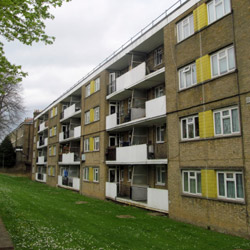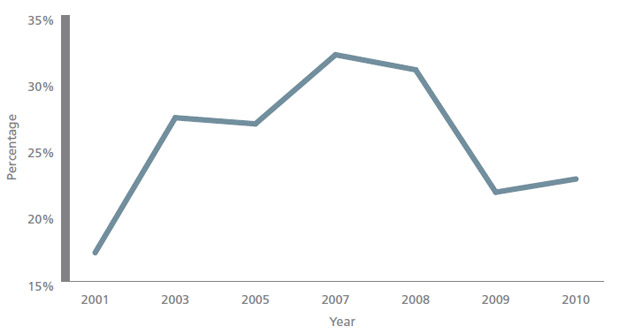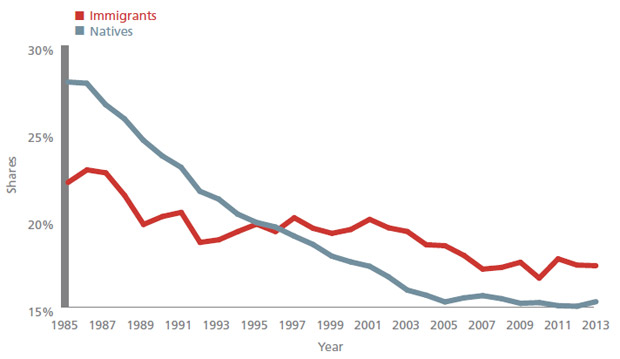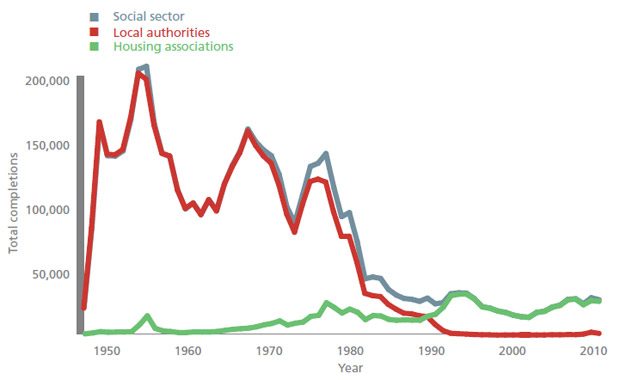
In recent research, we have been looking at the access of immigrants to social housing. This is important because rents in the social sector remain substantially below those in the private sector, and the social sector offers much greater stability of tenure. So social tenancies are very valuable to certain parts of the population.
Around a quarter of white British people in the UK feel that they are treated worse than people of other races by social landlords (councils and housing associations). As Figure 1 shows, this perception has varied a little over time but it has been consistently high. Such a level is extremely high – only the black community feel more discriminated against by parts of the criminal justice system than white people do by social landlords.
Figure 1: Percentage of the white British population saying they thought they would be treated worse than people of other races by a council housing department or housing association1.

Organisations like the British National Party try to exploit these feelings, spreading the view that ‘immigrants come here and are immediately given council homes while natives are pushed further and further back in the queue’. But is there any truth in this perception?
Who is eligible for social housing?
To be offered a social tenancy, an individual must first be eligible to ‘go on the waiting list’. There is no automatic eligibility for social housing for anyone in the UK (and the 2012 Localism Act has given local authorities more power to refuse to put an applicant on the waiting list). Indeed, the rules on eligibility are so complex that it is not possible, with existing data sources, to work out how many immigrants are eligible for social housing.
But at the risk of oversimplification, we can try to get a rough estimate using data on citizenship and length of time resident in the UK. UK citizens (whether acquired by birth or naturalisation) will generally have eligibility, as will immigrants from the European Economic Area (EEA) who have the right to reside in the UK, and non-EEA immigrants who have indefinite leave to remain (typically granted after about five years).
Table 1 below shows that most immigrants in the UK are in categories where they would be expected to be eligible. And even those individuals who are not eligible (the final line of Table 1) might access social housing if they are in a household where some adult does have eligibility – this is shown in the second column of Table 1.
| Individual | Household | |
| UK-born | 0.0 | 31.0 |
| Foreign-born UK citizen | 42.1 | 28.2 |
| EEA non-A8 citizen | 16.5 | 12.3 |
| A8 citizen | 10.5 | 8.9 |
| Non-EEA, in the UK for more than five years | 17.7 | 11.6 |
| Non-EEA, in the UK for five years or fewer | 13.3 | 7.9 |
| Table 1: Individual and household characteristics of immigrants2 | ||
The bottom line is that it is probably over 90 per cent of immigrants in the UK who have eligibility for council housing. The same rules apply for housing association tenancies that are nominated by local authorities, but those that are not are even less able to discriminate against immigrants.
Who is in social housing?
But just because most immigrants have eligibility to apply for social housing does not mean that they will get access to it. Once on a list, most councils operate a points or banding system, which gives priority to certain types of households. Councils have considerable discretion in the nature of this system, but all use some assessment of needs, for example, household size and economic circumstances.
A simple comparison of the probability of being in social housing for immigrant and native households leads to the conclusion that EEA immigrants are less likely to be in social housing and non-EEA immigrants are more likely to be in social housing compared with natives – this is column (1) of Table 2. But this is not comparing like with like – immigrants and natives differ in their household structure and economic circumstances. As column (4) of Table 2 shows, controlling for these factors reveals that immigrant households are less likely to be in social housing than equivalent native households.
| (1) | (2) | (3) | (4) | |
| UK citizen, foreign-born | +7.9* | +6.8* | +2.4* | -2.2* |
| EEA non-A8 citizen, foreign-born | +1.1* | -0.5 | -4.8* | -8.4* |
| A8 citizen, foreign-born | -3.5* | -3.9* | -4.7* | -12.7* |
| Non-EEA citizen, foreign-born | +5.2* | +6.3* | +1.5* | -7.1* |
| Controls | None | Demographic |
Demographic + regional |
Demographic + regional + economic |
| Table 2: Differences in the probability of being in social housing for immigrant households relative to native households (adding demographic, regional and economic controls)3 | ||||
Changes over time
This suggests that fears that immigrants somehow are given priority over equivalent native households in access to social housing are misplaced. But one source for the perception may be the following. Doing the same analysis for the late 1980s reveals that immigrants were very much less likely than equivalent native households to be in social housing. At that time, the allocation rules acted to reduce access to social housing for immigrants and ethnic minorities.
This change is very clear from the fractions of natives and immigrants in social housing. As Figure 2 shows, in the late 1980s, natives were much more likely than immigrants to be in social housing, but this was reversed by about 2000. These are the raw data, but controls for other factors suggest that this is a robust conclusion. It was plausibly the outcome of changes in the allocation rules in the 1980s and 1990s.
Figure 2: Shares of immigrants and natives in social housing over time.

But as the access of immigrants and ethnic minorities to social housing improved, the stock of social housing was not increased. Indeed, as Figure 3 shows, construction of social housing has dropped to a very low level. So necessarily, the improved access for immigrants and ethnic minorities coincided with reduced access for natives. It is plausible that this change is what led to the widespread perception of discrimination against white natives.
Figure 3: Total completions of social housing.

Conclusion
Although most immigrants are likely to be eligible to apply for social housing, there is no evidence (once demographic, regional and economic circumstances are controlled for) that they have preferential access to social housing – if anything the reverse seems to be the case.
But it does seem that there is less discrimination against immigrants and ethnic minorities now than in the past and this removal of discrimination, coupled with a failure to increase the social housing stock, has reduced the availability of social housing for UK native households.
This is probably the source of some people’s perception of discrimination. They are probably right to think that the part of the population attracted to social housing has been neglected, but they are wrong to think that this neglect applies just to them and not to immigrants as well.
This article summarises ‘Immigration and the Access to Social Housing in the UK’ by Diego Battiston, Richard Dickens, Alan Manning and Jonathan Wadsworth, CEP Discussion Paper No. 1264. This article first appeared on the LSE Politics & Policy blog.
Footnotes
- 1. Source: Citizenship survey, various years.
- 2. Source: Labour Force Survey, 2007-13 pooled; A8 citizens are those from the eight East European countries that joined the EU in 2004.
-
3. Source: Labour Force Survey, 2007-13; *denotes significantly difference from zero at 5% level. Notes: Demographic controls are the number and age of adults and children in a household; regional controls divide the country into 20 regions; and economic controls are the number of working adults and the highest-paid occupation of any adult. The numbers in column (4) represent differences in the probability of being in social housing for immigrants relative to natives evaluated for a single adult workless household with two children living in the south east of England.




